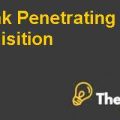Brief Introduction:
This case is mainly dealing with a copper based corporation Kennecott and its acquisitions and mergers strategies for the purposes of diversification in product lines and enhancing its liquidity condition to mitigate the losses of variations in copper prices and sales volume. They are mainly trying to discuss in this case about the style of management to make decisions of acquiring a company and its way of forecasting the valuation before offering a final deal price.
Under this case, they have discussed two major acquisitions done by the Copper Corporation named Kennecott which in the year 1968 acquired based company with the brand name Peabody which was going through operational losses and had a weak financial position. Major purpose of acquiring a loss bearing Coal based company was to diversify its business from copper to coal as well so that it can diversify its product line. At the time of acquisition, both were leading in their relative products, Kennecott was the largest copper producer domestically whereas, largest coal producer domestically was none other than the target company Peabody.
Kennecott Copper Corporation Harvard Case Solution & Analysis
After the divestiture of Peabody, company had to acquire another company to maintain its liquidity and diversification position so they acquired Carborundum Company in year 1997 so this case will be dealing in pre-acquisition position and post-acquisition position of Kennecott Corporation, its benefits and gaps as well as the management style while communicating this news to its shareholders in their general meetings to get this change in structure approved from majority of its shareholders.
Acquisition of Peabody Company:
As already discussed above, Peabody Company is the largest coal producer domestically in USA which was acquired by the Copper based company at an offer price of around $47.5 per share against the market price of per share $30 at that time which shows a premium of around $17.5 per share.
As both the products Copper and coal relate to the same industry and they are related products of Mining industry so it leads to the Vertical integration or merger for the acquirer. This would lead to the two benefits to the acquirer by developing strategic relationships with coal producers in the form of diversifying its business line by forecasting its potential investments in different product line and minimizing its portfolio risk as well as in the form of mitigating the volatility of the varying prices of copper and its sales volume.
Unfortunately company was not able to obtain these benefits up to the mark from this deal as Target Company was earning very less and it eventually reduced the overall share price of the acquirer company after merger as they had to bear huge capital investments for the protection of the environment. Moreover, they also had spent a huge chunk of amount in the equity of Peabody amounting to $532 million for running its operations and maintaining its earnings in a relatively better position. They were just given a benefit of tax shield by recording a relatively lower consolidated earnings of acquirer plus Target Company..........................
This is just a sample partial work. Please place the order on the website to get your own originally done case solution.










